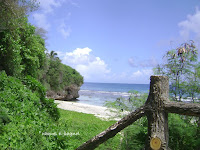
Three things happened the moment I laid eyes on the majestic stairways of cascading waters of Aliwagwag falls for the first time. I was dumbfounded, entranced and promptly fell in love.
Aliwagwag falls was an absolutely refreshing sight after being literally jampacked in a bus for over four hours, suffering the heat and mixed odor of more than a hundred enthusiastic mountaineers and spelunkers who responded to the invitation of the Department of Tourism 11 late last year.
We were alI quite unprepared for the sight of one the most beautiful waterfalls in the country which Cateel, one of the oldest towns in Region XI can boast of.
Located amidst thick forests some 25 kilometers away from Cateel proper, Aliwagwag Falls towers from a total of 1110 feet or 338 meters, cascading over 186 stairways of varying heights and appearing like a stairway to the sky, the tallest single drop of which is 100 feet (30 meters) with an average width of 30 feet.
Considered as the highest and one the most beautiful waterfalls in the country, Aliwagwag Falls flows into the pristine waters of Cateel river which was a successive awardee for two years as the Cleanes

t Inland Bodies of Water in Region XI and finalist in the national level.
Words are inadequate to describe the glory of Aliwagwag falls. The best way is to keep silent and let the wonders of its natural beauty engulf you. Bathing in Aliwagwag's clear and cool waters is an experience one will find hard to forget.
After a hasty lunch, we started picking our way through shrubs and thick foliage, clawing and conquering slippery 70-80 degree slopes to get to another feature of Cateel which occupies a place in history, the burial site of long-dead lumads.
Located in the midst of a thick forest just near Aliwagwag Falls is a big stone resembling a cave. From outside, no one would think that beneath the cavernous rock lies several bodies of long-dead members of the Mandaya tribe, or Lumads.
Legend has it that years and years ago, a member of the tribe chanced upon a piece of woven Mandaya cloth called "dagmay" and he kept it for himself.
After that, misfortune one after another fell on him until he died and was buried inside the big stone wrapped in the "dagmay" cloth. Since then, the members of the Mandaya tribe followed suit in wrapping their dead members in dagmay cloth and burying them inside the stone.
The Mandayas' unadulterated culture and traditions are still very evident in the remnants of partially buried "dagmay" we saw on the stone floor. Skeletal remains were scattered all over as well as the remains of a wooden casket. It was eery inside and I could almost feel the spirits of the long-dead people, as though their spirits were still trapped inside.
Then its time for the two-kilometer walk back to Barangay Maglahus for the night and be with the other spelunkers. We had to pass by a long stretch of swaying, stomach-churning footbridge to get to the campsite.
The next day took us into the dark depths of the Kasambunutanan or the Pagbuwaan caves. We washed off the cave's mud later by following a river trail up into the majestic Mabuyong falls.
***
Breathtaking waterfalls, caves and caverns represent some of the most unique, fascinating features of Davao Oriental. From the comfort of your keyboards, browse through the natural wonders of Cateel or much better, leave your daily routines to take an actual trek into the province of Davao Oriental with and see, feel and experience what it has to offer. You just can't help but fall in love as I did!
How to get there:
Cateel, which is some 360 kilometers from Davao City is accessible by buses and L300 vans in various terminals in Davao city.


 ut in Marpi and you will see them along the road. Just be careful not to break the piles, or better yet you can add to the cairns.
ut in Marpi and you will see them along the road. Just be careful not to break the piles, or better yet you can add to the cairns. 




 Darkness was about an hour away and yet I insisted on making a stop to this spot which I just heard about from others. The long fingers of dusk began to claim dominance over the skies, casting a somewhat eerie yet fascinating atmosphere.
Darkness was about an hour away and yet I insisted on making a stop to this spot which I just heard about from others. The long fingers of dusk began to claim dominance over the skies, casting a somewhat eerie yet fascinating atmosphere. 








 Come with me as we visit yet another one of the unique spots this island has to offer.
Come with me as we visit yet another one of the unique spots this island has to offer.
 Tourists wander around the Last Command Post. At the backdrop is the Suicide Cliff.
Tourists wander around the Last Command Post. At the backdrop is the Suicide Cliff.
 Going into the inner chamber of the cave.
Going into the inner chamber of the cave.







 Diving
into the blue depths of the Saipan Lagoon does not necessarily require
you to be a certified diver, or an expert swimmer. You can explore the
depths and stay dry aboard the “Deepstar”, Saipan’s newest and only
submarine tour.
Diving
into the blue depths of the Saipan Lagoon does not necessarily require
you to be a certified diver, or an expert swimmer. You can explore the
depths and stay dry aboard the “Deepstar”, Saipan’s newest and only
submarine tour.






